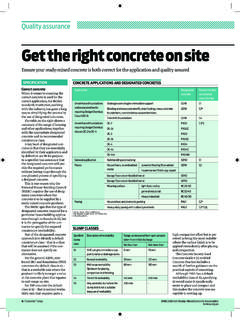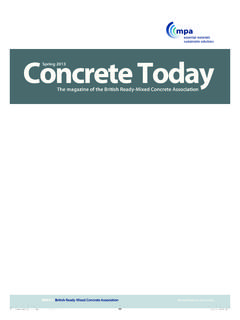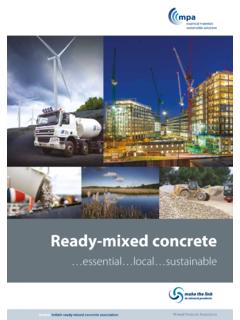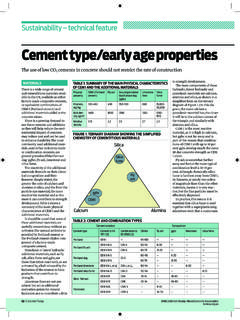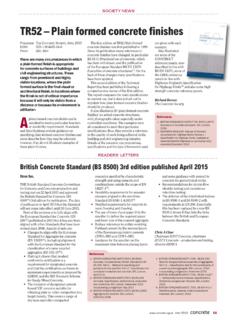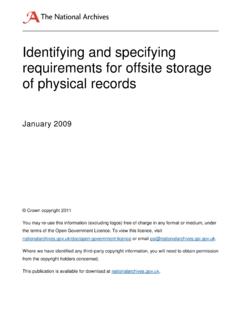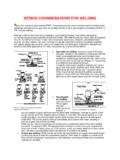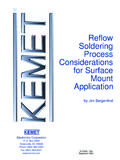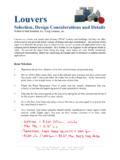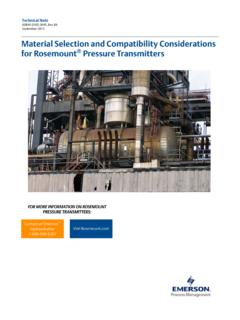Transcription of STRUCTURES | SUSTAINABLE CONCRETE SPECIFYING …
1 SUMMER 201426 STRUCTURES | SUSTAINABLE CONCRETESPECIFYING SUSTAINABLE CONCRETEM inimising the environmental impact of CONCRETE requires a detailed understanding of location factors and constituent materials. Jenny Burridge and Dr Chris Clear explain CONCRETE , in its simplest form, is made by mixing a cementitious binder, aggregates and water. This is then poured into a mould, or formwork, where it sets to form the dense, durable substance we know as CONCRETE . The proportions and types of binder, aggregate and water can be changed and admixtures or fibres added to give different properties to the CONCRETE either in its liquid or hardened state. Choosing the correct CONCRETE specification for the location and function of the CONCRETE is the essence of SPECIFYING SUSTAINABLE CONCRETE . The relevant British standard is BS 8500-1, and this should be referred to when SPECIFYING CONCRETE in the biggest proportion of the embodied carbon dioxide (eCO2) in CONCRETE is from Portland cement, or CEM I.
2 Aggregates, additions and water are naturally low in eCO2. All constituent materials are also plentiful in supply locally and Trafford Town Hall in Manchester, by 5plus Architects, where 50% cement replacement was specified. Watch a recent CONCRETE Elegance presentation by the architect hereSUMMER 201427 STRUCTURES | SUSTAINABLE CONCRETES pecification methodsThere are five methods for SPECIFYING concretes in BS 8500. These are given in figure 1, classesStronger concretes tend to be more FIGURE 1: SPECIFICATION METHODSS pecification methodWhen should it be used?Key considerationsDesignated concreteMass or reinforced CONCRETE where strength is important and there are no chlorides present. Foundations where there are no chlorides be used if chlorides are present. This method allows the CONCRETE producer flexibility to select the most appropriate materials to give the required concreteReinforced concretes, particularly where there are chlorides present.
3 Visual (fair-faced) CONCRETE . Where lower-carbon concretes are particularly method allows the specifier to define the CONCRETE required. The CONCRETE producer has some flexibility in the mix design to ensure that the performance requirements are prescribed concretesSite batching where ready-mixed CONCRETE cannot be used. (At maximum cement content, the highest strength class that may be assumed for structural design is C20/25.)The strength of the CONCRETE cannot be specified and the cement content tends to be significantly higher than that for a designed or designated CONCRETE . Do not use this method if a lower-carbon CONCRETE is concreteSpecialised concretes where the specifier takes full responsibility for the performance of the strength of the CONCRETE cannot be specified. Suitable if a CONCRETE technologist is SPECIFYING the CONCRETE .
4 There is no flexibility for the producer to account for any inherent variation in the materials used in the concreteCan be used for a number of high-performance concretes such as self-compacting concretes, low-shrinkage concretes, coloured concretes or high-strength CONCRETE composition is designed by the CONCRETE producer to provide a certain performance. The composition of proprietary concretes is confidential to the , and a mix that will endure for 100 years inside a building may not last as long in the sea. BS 8500 gives six exposure classes for different types of environment (figure 2). These are then subdivided depending on the FIGURE 2: EXPOSURE CLASSESE xposure classForm of attackSubclassExample of location type X0No risk of corrosion or attackMass CONCRETE not exposed to freezing or sulphates in the groundXCCarbonationXC1 InternalXC2 WetXC3 Damp, or cyclic wet/dryXSChlorides in sea waterXS1 External CONCRETE near the seaXS2In the seaXS3In the tidal zoneXDChlorides not from sea waterXD1 Possible spray from de-icing saltsXD2 Permanently in salt waterXD3 Areas where de-icing salts are used such as car park slabsXFFreeze-thawXF1 External vertical surfaces without de-icing saltsXF2 External vertical surfaces with de-icing saltsXF3 External horizontal surfaces without de-icing saltsXF4 External horizontal surfaces with de-icing saltsACECA ggressive ground conditionsAC-1s to AC-5mFoundations in non-aggressive (AC-1s) to very aggressive (AC-5m)
5 Soilsdurable, but also higher in embodied energy, so it is worth thinking about the location and SPECIFYING accordingly. CONCRETE that is to be exposed to rain, frost or chemicals will require a different specification to CONCRETE in an internal dry SUMMER 201428 STRUCTURES | SUSTAINABLE CONCRETE severity of the environment. Note that carbonation and chlorides will affect the reinforcement within the CONCRETE , and therefore do not apply to mass CONCRETE . Freeze-thaw and aggressive ground affect the CONCRETE matrix and therefore apply to both reinforced and mass durability required for these exposure classes is given in BS 8500 as CONCRETE strengths and cover to the reinforcement. The stronger concretes tend to be more impermeable and therefore less vulnerable to penetration by water, chemicals, carbon dioxide (which leads to carbonation) or chlorides.
6 The CONCRETE Centre s publication How to Design CONCRETE STRUCTURES Using Eurocode 2: BS 8500 for Building STRUCTURES provides a summary of the tables in BS 8500, giving CONCRETE strengths, covers and allowable cement will be more prone to corrosion where exposed to chlorides than just by carbonation. Therefore, if chlorides are present, the tables covering XD or XS exposure classes should be biggest proportion of CONCRETE is normally aggregates, typically making up around 70% of the total volume. These can be primary aggregates, quarried to be made into CONCRETE ; secondary aggregates, which are by-products of another process; or recycled aggregates which tend to be crushed CONCRETE from demolition or waste. Recycled aggregates are further sub-categorised as: n RA (recycled aggregate), which is comprised of any inorganic material previously used in construction and can include a high proportion of masonryn and RCA (recycled CONCRETE aggregate) which is comprised of crushed CONCRETE .
7 For the purposes of BREEAM assessments, secondary aggregates are considered as recycled to the crushing process, recycled aggregates contain a proportion of fine material that increases water demand and may increase drying shrinkage and creep of the hardened CONCRETE . Coarse recycled aggregates can be used FIGURE 3: PERCENTAGE OF RECYCLED AGGREGATES ALLOWED IN DESIGNATED CONCRETESD esignated concreteAllowable percentage of coarse RA or RCAGEN 0 to GEN 3100%RC20/25 to RC40/5020%*FND120%*RC40/50XF0%PAV1 and PAV20%FND2 to FND40%* Except where the specification allows higher proportions to be usedin concretes specified to BS 8500. For designated concretes, recycled aggregate can be used to the percentages shown in figure 3 without further specification. A greater percentage can be specified, but there should be rigorous testing to ensure that it does not contain anything deleterious to the reinforcement or CONCRETE .
8 The allowable limits for secondary SUMMER 201429 STRUCTURES | SUSTAINABLE CONCRETE aggregates are far higher, with the exact percentage dependant on the type of aggregate and its recycled aggregate can be used in CONCRETE , it may increase the eCO2 because more cement is required due to the increased water demand. Recycled aggregate transported further than 15km by road is likely to have a higher eCO2 than primary aggregate. Often the most SUSTAINABLE use will be in other applications. All recycled aggregate that is available is fully ESSENTIALS Tips for SPECIFYING SUSTAINABLE CONCRETE Do not over-specify strength Do not specify aggregate sizes below 10mm unless necessary Permit the use of recycled or secondary aggregates but do not over-specify. Recycled aggregates should only be specified when they are locally available Embodied CO2 (eCO2) of CONCRETE should not be considered or specified in isolation of other factors such as strength gain Use of additions can reduce the eCO2 of CONCRETE and influence its appearance.
9 When aesthetics are critical, specify the cement/combination to maintain colour consistency Permit the use of admixtures as these can be used to reduce the eCO2 and the environmental impact of CONCRETE , as well as modifying its physical properties Specify BES 6001, responsibly sourced CONCRETE and reinforcementLEFT The CONCRETE frame of Duggan Morris Architects Ortus learning centre in south-east London contains 50% GGBS. Watch a CONCRETE Elegance presentation by the architect here Photo: Jack HobhouseSUMMER 201430 STRUCTURES | SUSTAINABLE CONCRETEC ementitious materialCement is not only made of Portland cement (CEM I) but can also include additions such as fly ash and ground granulated blast furnace slag (GGBS). These additions provide some useful benefits, such as durability, workability and lower heats of hydration.
10 They are also products recovered from other industries, and are therefore low in eCO2, and their use can reduce waste to landfill. Most modern ready-mixed concretes in the UK include an that contain high levels of additions have longer setting times than pure CEM I concretes, and are therefore more suitable for foundations or ground-bearing slabs. Lower levels of additions, up to approximately 35% GGBS or fly ash, should not significantly extend the striking times for suspended CONCRETE slabs in reasonable weather. In cold weather the strength gain of CONCRETE is reduced and therefore the percentage of additions that will still allow a striking time of about three days is also 4 shows the relative strength gain of concretes with different 020406080100120140160110100 Age, daysStrength ratio, 28 days = 100 Cement types28 days90 days7 days3 daysCEM ICIIA-D 8% silica fume, plus super-plasticiserCIIA-L 15% limestoneCIIB-V 30% fly ashCIIIA 50% GGBSCIIIB 70% GGBSCIVB-V 50% fly ashFIGURE 4: THE EARLY AGE STRENGTH GAIN OF DIFFERENT CONCRETE MIXES proportions and types of additions.
